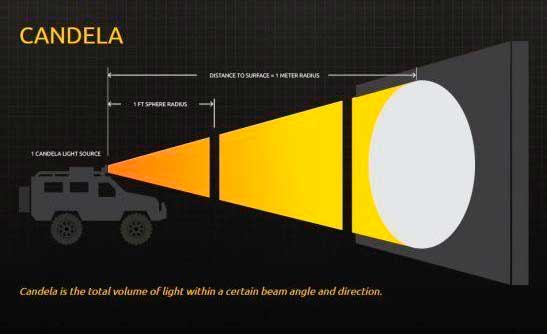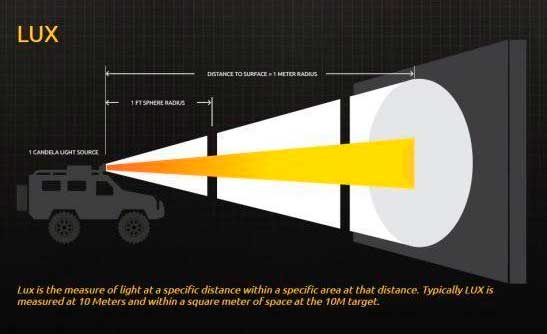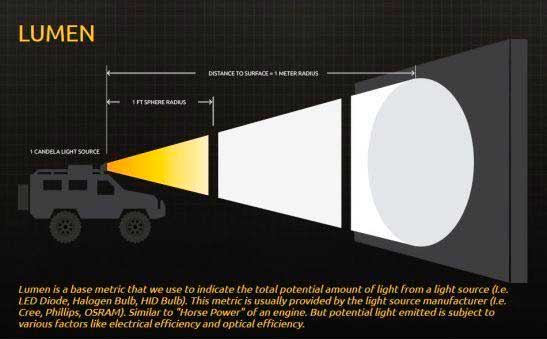If for some reason you're interested in understanding a light bulb's brightness, you may see two metrics – lux and lumens. Both are related to brightness but measure slightly different things.
In this article, we will explain the core differences between those two and how they can be managed on different occasions.
The lux takes into account the area over which the luminous flux (lumens) is spread, which is the difference between lumen and lux. When concentrated over a one-square-meter area, a flux of 1000 lumens produces an illumination of 1000 Lux.
For instance, with 500 lux, a 500-lumen light source can illuminate one square meter. The very light source that needs to enlighten 10 square meters enlightens this region with just 50 lux.
Currently, light is measured in lumens; this shows how much light comes from the light source all around, no matter which way it was shining.
Because it indicates how effectively the light source converts power into light, efficiency is particularly significant in lumen. The ratio of lumens to watts is named for this.
This value is much higher for LED lights because they require less power to generate a specific lumen current, to compare watts to lumens.
One lux is equivalent to one lumen per square meter and it is used to measure the amount of light that is produced in a given area. We are able to measure both the total amount of visible light that is present on a surface and its intensity.
As a result, the direction in which the light source shines matters. This value is constant regardless of the color, number of light sources, or structure in which the light shines. If a lamp shows the lux, it’s usually in the center of the beam where the most light is concentrated.
Therefore, what distinguishes lux, candela, and lumen?

Lumens are how much light is emitted. The luminosity of your surface is called lux. Candela estimates the visible force from the light source. So, lumens measure how much light is delivered by a light or lighting installation; the more lumens, the brighter the light will be.
So, what is lux?

The SI unit for luminous intensity is the lux, or lux. It is utilized to gauge illuminance, the brightness of an object, or how much light is beaming on a surface.Lumens and lux are the two units of measurement used to describe light intensity.
So, what is the contrast between lux and lumens?

The total light output of a single light source, regardless of its direction, is measured in lumens. The number of lumens that reach a surface is measured by lux.
Therefore, lumens indicate the overall brightness of a single light, whereas lux indicates the amount of light reaching a surface from any number of light sources.
Lux tells you how much light is required to achieve a particular level of brightness on a surface or a room as a whole. A level of lux is suggested for the use of the space to make sure there is enough light to do the job safely and comfortably there.
There are specific requirements for each nation and state, but the following are some typical applications for lux measurements.
Lux doesn't characterize how bright a light source is but rather how bright it will be within given distances and beam angles. Lux is therefore a more unambiguous measurement about the utilization of the lumen yield from a light and less useful for a comparison between light sources.
The closer to the light source, the higher the lux reading. This is because light scatters as you move away from the light source.
In this manner, when you look at a lux rating for a light, you should always ensure there is a distance related. For instance, you might see 1000 lux at 4 feet. In the event that you only see a lux rating, you won't know what distance this is measured at, and you cannot make a legitimate comparison.
For most directional light sources, for example, LED, the center of the beam typically has the highest lux reading. As you create some distance from the center, lux will diminish.
When to use lux versus lumens
lux is important for determining the brightness of a surface. If you want to know how bright a tabletop, reading material, or photography subject will appear, this is the most important metric.
On the other hand, lumens are significant for knowing how much light a single light source produces. This is useful for comparing the total amount of light emitted by a bulb, but it is not always possible to determine whether it is enough for a space or task due to its light distribution and the size of the space.
Differences in measurement methods between lumens and lux because lux is a measure of how much light hits a surface, even a small handheld light meter or spectrometer can measure how much light hits a surface. These are commonly lower cost and can surprisingly be connected to smartphones and used in the field.
In contrast, lumens measure the total amount of light emitted in all directions by a single light source. Hence, somewhat more refined instruments are required.
An integrating sphere is typically required with these instruments to measure the total amount of light that is emitted after capturing the light from all angles.
Lumen and lux are closely related concepts
While lumens measure how much light is produced by a source, lux decides a similar amount of light but is projected onto a surface. Accordingly, one lux is identical to one lumen per square meter.
To put it succinctly, this measurement is used to determine the total amount of visible light and its intensity over a specific space. The center of the angle, where the brightness is greatest, is typically used to indicate this.
When the ideas of lux and lumen are clear, understanding the distinction between the two measurements is much more straightforward. The main difference is that lumen measures the luminous flux regardless of the distance at which the light source is placed or the space it illuminates, whereas lux measures the intensity of light on a specific translucent surface.
Based on these recommendations and the client's specific preferences, experts recommend luminaires that meet requirements without having to compare certain characteristics of lux and lumen.
But the core difference can be summarized: the lux is a measure of illuminance, the total amount of light that falls on a surface. Lumens is a measure of luminous flux, the total amount of light that’s transferred in all directions.